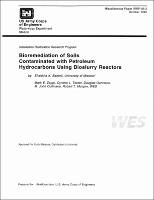Please use this identifier to cite or link to this item:
https://hdl.handle.net/11681/7763| Title: | Bioremediation of soils contaminated with petroleum hydrocarbons using bioslurry reactors |
| Authors: | University of Missouri--Columbia. Department of Civil and Environmental Engineering Installation Restoration Research Program (U.S.) Banerji, Shankha K. Zappi, Mark E. Teeter, Cynthia L. Gunnison, Douglas Cullinane, M. John Morgan, Robert T. |
| Keywords: | BTEX Polycyclic aromatic hydrocarbons PAH Total petroleum hydrocarbons TPH Bioslurry Biotreatment Bioremediation Military installations Soils Oil Petroleum |
| Publisher: | Environmental Laboratory (U.S.) Engineer Research and Development Center (U.S.) |
| Description: | Miscellaneous Paper Abstract: The Department of Defense has over 12,000 sites contaminated from military activities. Many sites contain petroleum contamination and residues from fueling, maintenance, and training activities. Use of bioslurry reactors may be an appropriate means for decontaminating these soils. This report presents data from two bench-scale and two pilot-scale studies that evaluated the suitability of the bioslurry process to bioremediate soils contaminated by petroleum hydrocarbons. Soils from two contaminated sites were studied. The first soil contained polycyclic aromatic hydrocarbons (PAHs), BTEX (benzene, toluene, ethylbenzene, and xylene) compounds, ketones, and chlorinated ethanes; the second soil contained gasoline and associated compounds. Conceptual designs and costs of bioslurry processes for field applications are also presented. Bench-scale studies were performed in 5-L batch reactors, equipped with aeration and mixing equipment. Various nutrient amendments, surfactants, and selected microbial consortia were evaluated during the bench-scale studies. Several reactors were also operated using only native microbes. Pilot-scale testing was accomplished using 60-L EIMCO reactors, also equipped with aeration and mixing systems. Off-gases were recirculated, with CO2 removed in a scrubber and additional O2 added as required. The results from both bench- and pilot-scale testing indicated that native microbial species in contaminated soils can biodegrade total petroleum hydrocarbons, volatile organics (BTEX), and PAH compounds to low residual values at reasonable retention times. Removal of PAHs ranged from 47 to 97 percent, TPH removal from 68 to 83 percent, and volatile compounds removal from 61 to 99 percent. Vapor recirculation was required to prevent loss of volatile components from the reactor. Addition of surfactants was not formed to be beneficial in this study. The estimated cost for treating greater than 20,000 cu yd of contaminated soil ranged from $150 to $200/cu yd, depending on the type of system used. |
| Rights: | Approved for public release; distribution is unlimited. |
| URI: | http://hdl.handle.net/11681/7763 |
| Appears in Collections: | Miscellaneous Paper |
